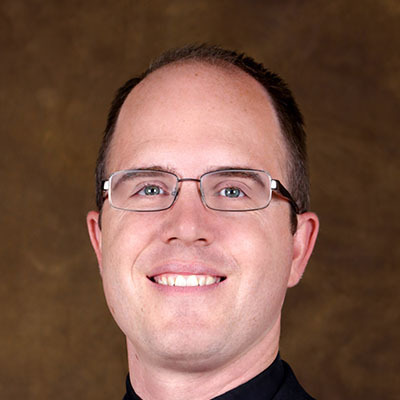No products in the cart.
Home » St. Joseph: A Model for Fathers Today
- Clergy Corner
St. Joseph: A Model for Fathers Today
by Fr. Matthew Spencer, O.S.J.
There I was again, in that musty, dimly lit confessional. I was twenty-three years old at the time, attempting to chart a course for happiness, and confession had become my compass of sorts, keeping me fixed on God along the winding path of my life. It had been a painful process though, mostly because I felt about as good at confession as I was with a compass, which is to say, hopeless. I’d been going to confession about once a month for years, confessing the same things over and over and over, and while I could point to spiritual north, my spiritual life always seemed to be heading south. I hadn’t given up on confession—I still haven’t, for that matter!—but the advice I received that day would eventually make the trek in sanctity a little bit easier
“You need to look to St. Joseph,” my confessor said, after I’d listed off my sins. “He’d be the perfect role model for you right now.” The advice surprised me for a couple of reasons. First, I knew almost nothing about St. Joseph. And second, the little I did know had nothing to do with anything I’d just confessed (or so I thought). I strode out of the confessional bewildered but curious, resolved to figure out what he was talking about. That confession wasn’t the most momentous of my life, but thanks to those words from that priest, it did prove to be a turning point. It led me to get to know St. Joseph better and to discover the powerful example and model he is for every Christian.
Many people imagine St. Joseph to be an accessory to the early life of Christ, or a decoration to the Christmas story, not much more than the figurine in their nativity scene. Even some who’ve been cultivating the Christian life for many years have simply missed getting to know the humble carpenter, the man invited by God to accompany and protect Jesus and Mary in those early years in Nazareth. Maybe they’ve overlooked him because his spirituality is humble and hidden. But if they took a deeper look, they would discover profound insight into the Christian life, and a model for every disciple of Jesus.
Pope Francis thinks so too. On December 8, 2020, to the surprise of nearly everybody, our Holy Father declared a Year of St. Joseph for the whole Church, an opportunity for Christians everywhere to look to the husband of Mary more intently. In fact, there are various reasons why Pope Francis decided to proclaim this year when he did. For one thing, December 8, 2020 marked the 150th anniversary of the declaration of St. Joseph as Patron of the Universal Church. For another, Pope Francis recognizes the darkness enveloping the world and the Church in the grip of a global pandemic, and he’s inviting us to look to St. Joseph for guidance on how to navigate these confusing and tumultuous times. But there’s another reason Pope Francis offers, a reason that I believe is perhaps the most significant in its scope: “Our world today needs fathers,” he wrote, and so he decided to declare the Year of St. Joseph to offer St. Joseph as a model for fathers to a world desperately in need of a renewal of authentic fatherhood.
How can St. Joseph be an example for fathers today? Three concrete points of reflection come to mind. First, in St. Joseph we see a man who is open to life. Although he didn’t anticipate the miraculous and unexpected news of the Incarnation, once he understood that his vocation was indeed to take Mary and Jesus into his home, he not only was open to this possibility, he embraced it completely. Too many fathers in our own day have instead embraced a contraceptive mentality, a disastrous worldview that claims that they can decide when life can be accepted and when it can be rejected. We see in St. Joseph an openness to life that is completely harmonious with his authentic affection for his beloved wife, Mary.
Second, we see in St. Joseph, a man willing to subjugate his own plans and his own future to the will of God and to the responsibilities of his own vocation. Instead of demanding happiness on his terms, he found happiness in serving the Lord, in caring for our blessed mother, and in always making Jesus the center of his family. Virtuous fathers discover that giving priority to God’s will and to the demands of their vocation leads to even greater happiness and fulfillment, as St. Joseph himself demonstrates.
And third, in St. Joseph we see a man willing to lead, yet to also give all the attention and glory to Jesus and Mary. So often, the temptation in our day is to find happiness in being validated by others, in being recognized for our achievements, in being noticed for our virtue. As St. Joseph was completely content to direct all focus to Mary and Jesus, so fathers today will only find the fullness of joy in their vocation when it is done for completely selfless motives, for the good of their spouse and children, and giving all glory to God.
In declaring this special Year of St. Joseph, Pope Francis understood well that fatherhood is in great crisis in our day. Yet he also sees that St. Joseph provides the perfect model for men of our day to live their vocation to fatherhood more faithfully. Although at first glance we might think that St. Joseph has little to teach us about our own vocations, with careful reflection we begin to see how appropriate it is that we now look to him during this Year of St. Joseph. Let us go to Joseph and learn from him the beauty and the craft of what it means to be a true father.
About The Author

Fr. Matthew Spencer, O.S.J.
Fr. Matthew Spencer, O.S.J. was ordained a priest of in 2009, and serves currently as Provincial Superior and Shrine Director for the Oblates of St. Joseph. When not traveling in service to the Oblates, or for speaking engagements, he resides at the Shrine of St. Joseph, Guardian of the Redeemer, in Santa Cruz, California
Comments
Commenting on articles is a member-only feature. Please sign up for one of our memberships to leave a comment.
Login
Please sign in as a member to comment.
0 Comments
Oldest
Newest
Most Voted
Inline Feedbacks
View all comments
Continue Reading Similar Articles
- 1
- 2
- 3
- 4
- 5
- 6
- 7
- 8
- 9
- 10
- 11
- 12


